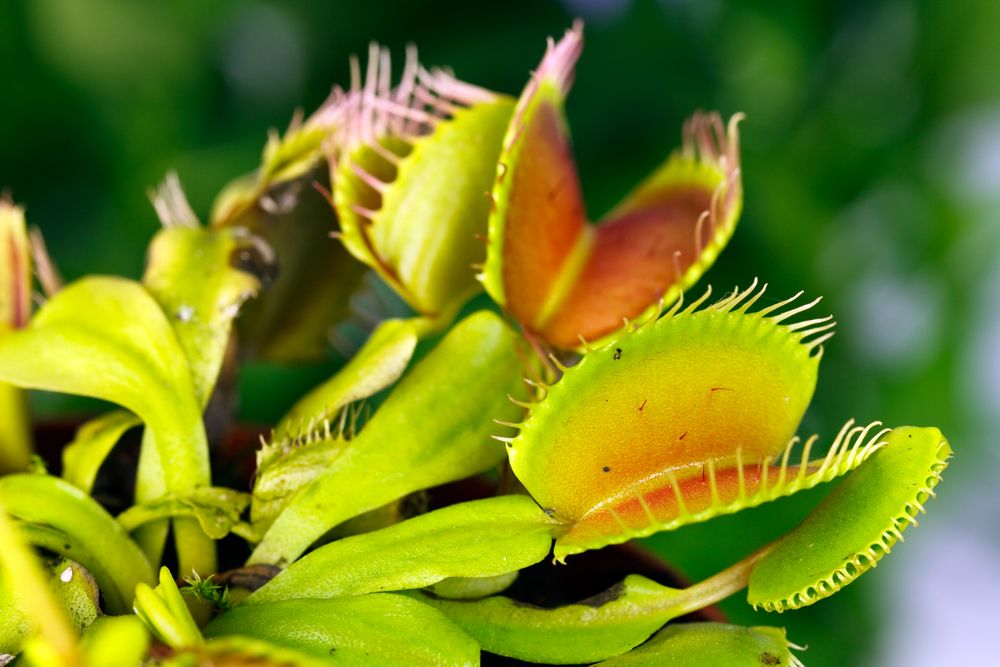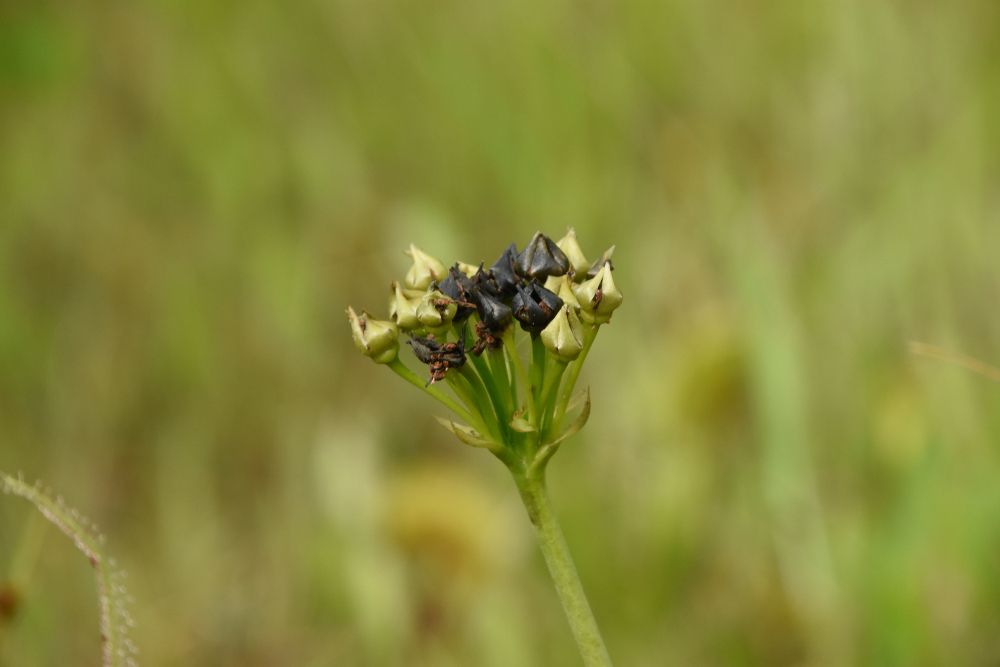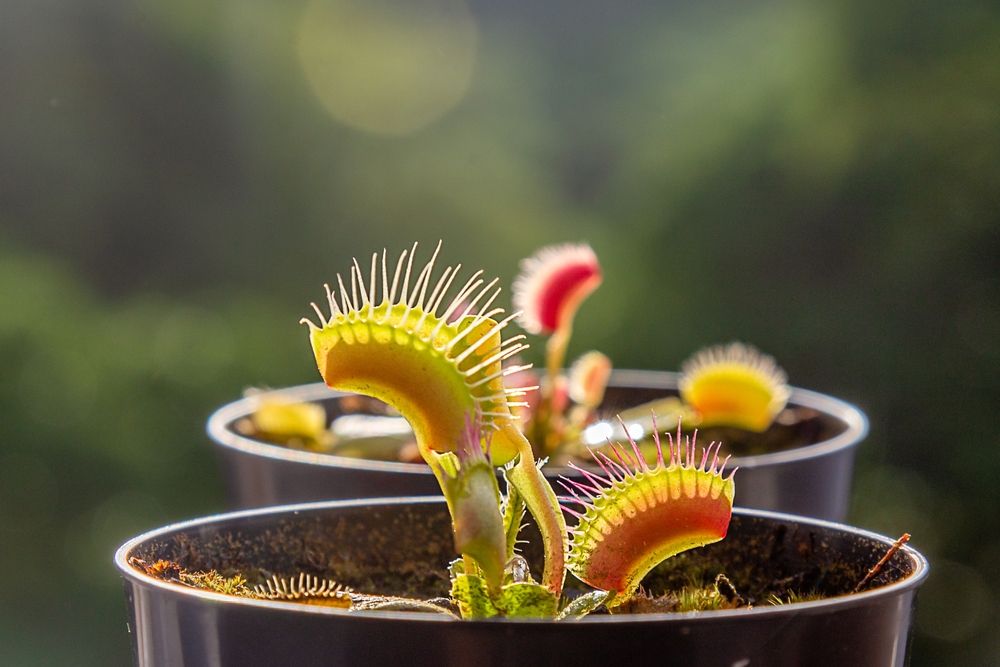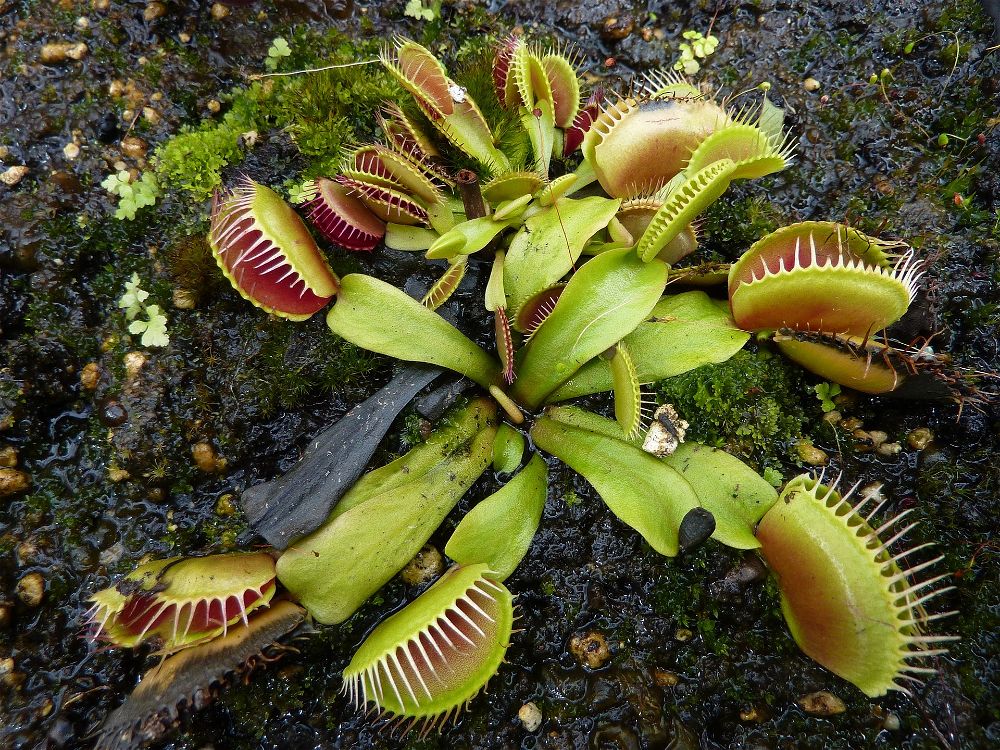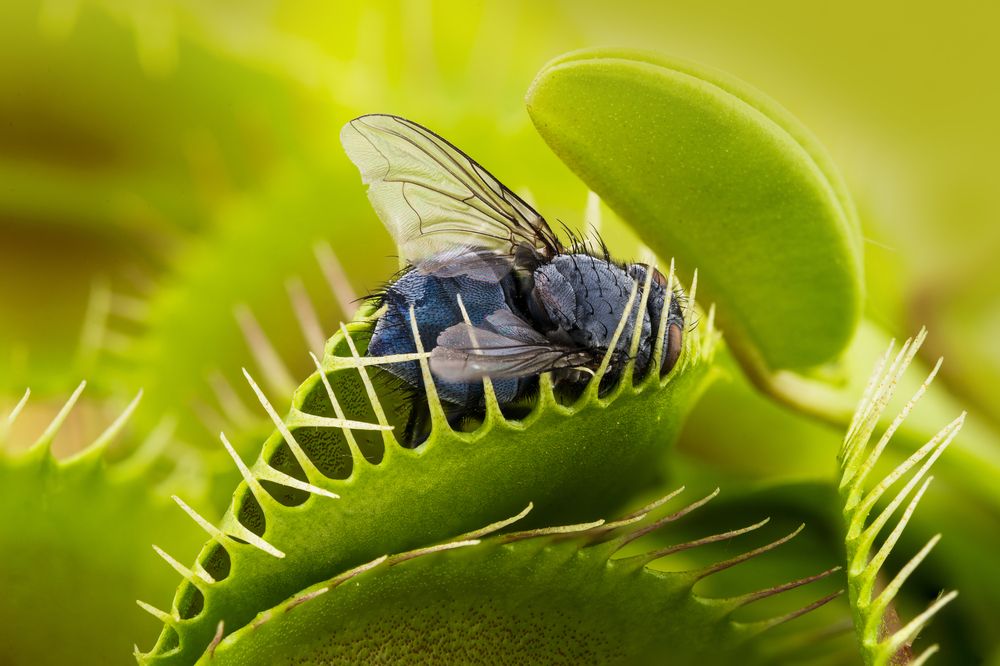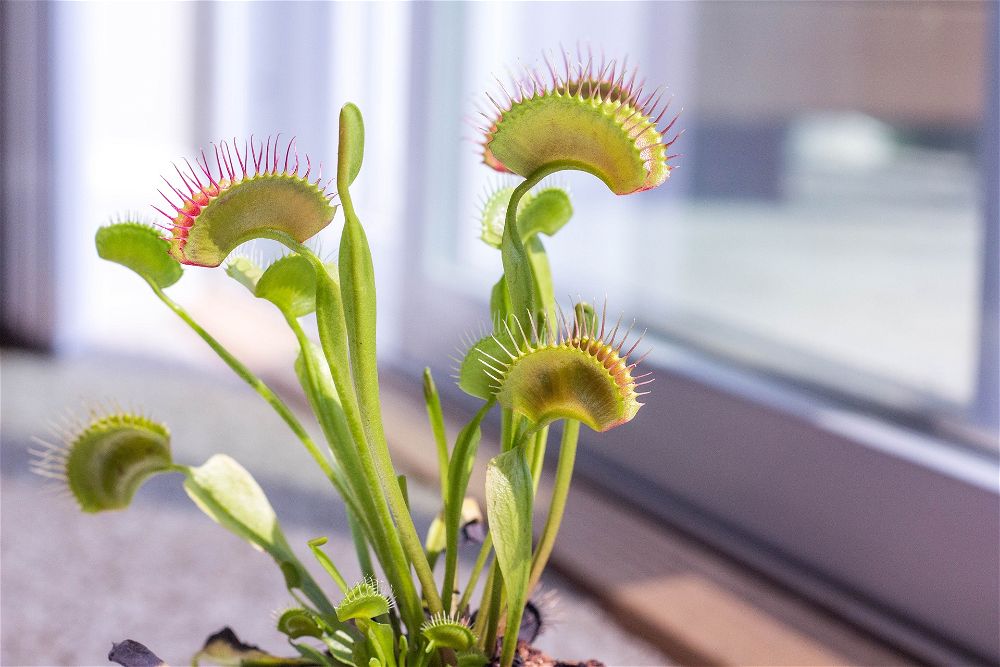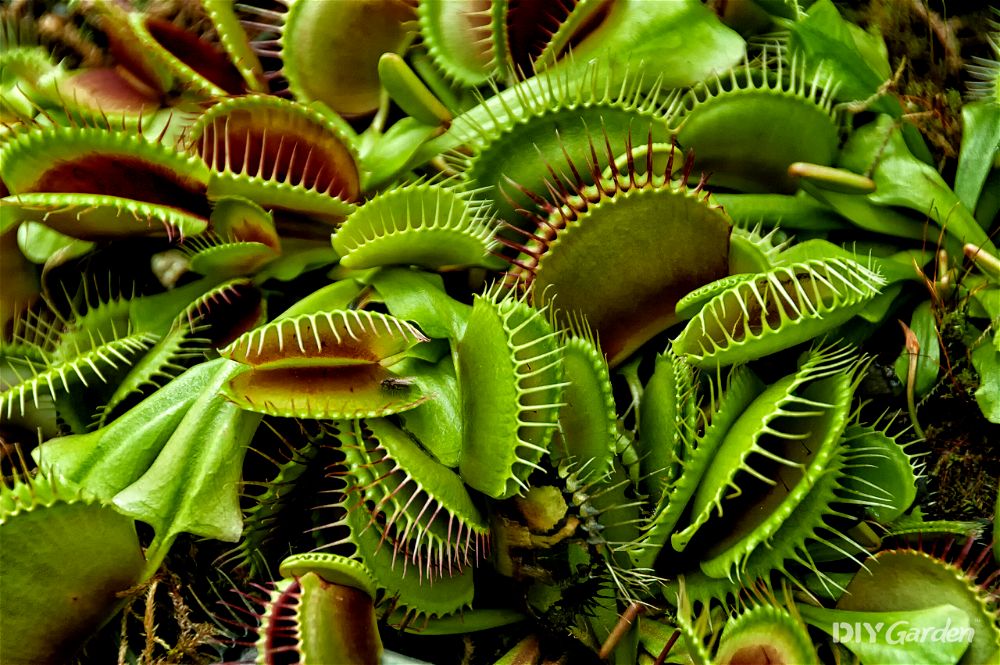
Although it may arguably be the most fascinating of carnivorous plants, Venus fly traps aren’t known for being particularly large. Usually, each trapping leaf grows to about 2-3cm in width, with one plant producing about 4-8 traps at one time.
However, those are average figures – they’re what you can expect when your plants are growing in average conditions. On the other hand, if you know what you’re doing, you can push the boundaries when it comes to how big your plants get. Not only will you be able to encourage each trapping leaf to grow to about three times the average size, but a healthy and happy Venus fly trap plant will also produce a larger number of traps.
Wondering how to make a Venus fly trap grow big? Read on – we’re about to share the best secrets!
How to Grow a Big Venus Fly Trap at Home
Originally from the coastal bogs of the Carolinas but now endangered due to habitat destruction, the Venus fly trap is famous for how its leaves snap close to consume any unfortunate insects that land on them. It’s a captivating watch no matter the size of the plant, but there’s no denying that the bigger it is, the more dramatic it seems.
In most parts of the world, the Venus fly trap is grown as a houseplant. However, unlike some of the other houseplants that you may have dotted around your home, your Venus fly trap will require some extra attention. So, let’s start with the basics – if you want your Venus fly trap to grow as big as possible, these are the growing conditions that you’ll need to provide:
Full Sun
Insufficient light is often why a Venus fly trap doesn’t grow as big as it could. When it comes to this carnivorous plant, the more light it receives, the better. 12 hours of direct sunlight per day would really enable your plant to thrive, but even 6-8 hours would be good. Anything less than 6 and not only will your plant remain small, but it’ll also likely weaken and soon die. If the interior of your plant’s traps turn red, then this is a sign that it needs more light.
The exception to the direct sunlight rule would be in the midst of the summer. In order to give their Venus fly traps plenty of light, most people place them in front of a sunny window. However, glass enhances heat, meaning that the intensity of the summer sun could prove to be too strong for your plant. If the leaves start to turn crispy, then they’ll need to be moved further back from the window for the hottest hours of the day.
What should you do if you can’t give a Venus fly trap 6-12 hours of sun each day, yet you’re still desperate to own one? Artificial lighting is the answer! This can be especially beneficial in temperate climates during the winter months.
Adequate Humidity
While many houseplants hail from tropical climates, the Venus fly trap’s natural environment would be classed as warm temperate. This means that the plant does enjoy a little bit of extra humidity, but doesn’t require as much as many other houseplants do.
In order to maximise its size, your Venus fly trap should be kept at a humidity of above 50%. A humidity dome can help with this but don’t keep your plant in one permanently – adequate air flow is also important for growth.
The Right Temperatures
In the Carolinas, summertime temperatures often reach 30°C before dropping down to just below 0°C in the winter, and the Venus fly trap is able to tolerate this full range. In fact, that range is vital to growing a large and happy Venus fly trap, since the plant needs cooler temperatures to trigger winter dormancy (more on this further down!).
How to Grow Big Venus Fly Traps from Seed
If you would like a big Venus fly trap as soon as possible, then it would be best if you purchased a mature plant – it can take 3-4 years for a Venus fly trap grown from seed to reach its adult size.
That said, if you’re patient, growing a Venus fly trap from seed can be very rewarding. By nurturing it in the correct way right from the start, you’ll end up with a plant that’s likely far healthier, and therefore larger, than anything you could buy.
Ideally, start with seeds that are as fresh as possible. Germination rates dramatically decline once the seeds are just a couple of months old, although refrigeration helps to prevent this. Then, follow these steps:
- Fill a pot with a 50/50 mix of peat moss and either sand or perlite
- Thoroughly water your peat moss/sand mix with distilled water
- Scatter your seeds over the surface – aim for around 20-25 seeds per 9cm pot
- Gently tap your seeds in and then sprinkle a very light layer of peat moss over the top. This isn’t necessary but it does help to retain moisture. However, don’t spread it too thickly as the seeds need light for germination
- Place the pot somewhere where it can receive consistent temperatures of around 23°C. A heated propagator would work well for this
- Keep the growing medium consistently moist and your seeds should germinate in 4-8 weeks
Once you notice seedlings appearing (they literally look like baby versions of the adult plant), place the pot somewhere bright – from this stage onwards, they’ll need plenty of light.
How to Plant a Venus Fly Trap in a Pot to Encourage Fast Growth
If you live somewhere that has a similar climate to that of the Carolinas, then you may get away with growing your Venus fly trap outdoors in the ground year-round. However, for everyone else, it would be best to plant your Venus fly trap in a pot. This way, you can either keep it indoors to have full control over its growing conditions, or you could even move it outdoors in the warmer months before bringing it back inside in the winter.
If you want your Venus fly trap to grow as large as possible, then you’ll need to pick the right pot. This is a plant that has long and chunky roots, meaning that a pot depth of at least 15cm is required. The more space you give to those roots, the better they’ll spread, meaning increased growth for your plant.
The growing medium that you use is vital too. Regular potting soil is a big no-no. Instead, go for a 1:2 mix of sand and peat moss. This will give your plant what it needs to thrive while also ensuring good drainage.
READ NEXT: How to Get Rid of Fruit Flies in Houseplants
How to Plant a Venus Fly Trap Outside
Venus fly traps are sometimes easier to cultivate when grown outdoors in the ground, so long as your climate allows for this. Growing outdoors means that the plant isn’t restricted in terms of space and also ensures a steady and natural supply of food, water, and circulation.
The downside to growing the plant outdoors is that you may end up compromising on size. This is down to how inconsistent outdoor conditions can be.
That said, if you would still like to give this a try, you’ll need to amend the soil in your planting area. Again, a 1:2 mix of perlite or sand and peat moss is ideal. Pick a location that receives plenty of sun and, if you can, choose somewhere that’s surrounded by acidic soil.
Caring for Your Plant: How to Make a Venus Fly Trap Grow Big
Even if your Venus fly trap is growing in near-perfect conditions, it will still need some extra care if you’re hoping that your plant will grow as big as possible. Here’s what you’ll need to do:
Watering Your Venus Fly Trap to Improve Growth
Although the Venus fly trap grows best in soil that’s consistently moist, there are a few watering rules that you’ll need to follow if you’re hoping to cultivate a larger-than-average plant.
For starters, be mindful of the water that you use. The Venus fly trap is extremely sensitive to water containing minerals, or even water that’s on the alkaline side, meaning that tap water should be avoided. Instead, either collect rainwater or use distilled water.
To encourage stronger roots, and therefore a bigger plant, water your Venus fly trap from below, rather than from above. This means sitting your plant in 1-2cm of water, so that the roots can directly soak up moisture. Do this regularly so that the soil never dries out, but don’t leave it permanently sat in water either!
What to Feed Your Venus Fly Trap to Make it Grow Big
Just like with any plant, ensuring that your Venus fly trap receives all the nutrients it needs will help promote growth. However, unlike many other plants, the Venus fly trap is carnivorous, meaning that a regular plant fertiliser won’t do the trick.
Instead, the main diet for a Venus fly trap consists of small insects with soft bodies. Some of the best insects to feed a Venus fly trap include:
- Flies
- Spiders
- Crickets
- Bloodworms
- Grasshoppers
- Small slugs
If your plant lives outdoors, then it’ll take care of feeding itself. However, if your Venus fly trap is a houseplant, then you’ll need to give it a bug to eat every 1-2 weeks.
What makes this tricky is the fact that the insects ideally need to be alive in order to trigger the plant’s digestive processes. The insects that you choose to feed also need to be a suitable size – don’t go with anything larger than 1/3 of the size of your plant’s traps. Feed it an insect that’s too big and the trap won’t be able to properly seal shut around it, which then allows bacteria to enter.
It’s also worth mentioning that you don’t need to be too diligent about regularly feeding your plant. A Venus fly trap will happily go for 1-2 months without any food, although this could end up impacting how large it grows.
Removing Decaying Leaves and Flower Stalks to Stimulate Growth
As your Venus fly trap grows, its older leaves will turn black while new leaves form from the center of the plant. While those black leaves will eventually decompose on their own, this process can take several months, resulting in over-crowded leaves. In order to stimulate growth, removing any black or decaying leaves once a month is vital.
Once your plant is about four years old, it will start to flower each spring. This isn’t a bad thing, but it means that your plant will be putting the majority of its energy into producing flowers, rather than into growth. So, if you want to make your Venus fly trap grow as big as possible and aren’t too fussed about saving seeds from your plant, cut off any flower stalks as soon as they appear.
Preparing for Winter Dormancy
A Venus fly trap needs to go through winter dormancy for 3-4 months each year. This allows the plant to rest. If it isn’t able to do so, it’ll weaken and will most likely die in a couple of years.
To enter dormancy, a Venus fly trap requires temperatures between 0-7°C. After a couple of weeks of this, it will start to lose its leaves and may even reduce in size. This is completely normal and enables the plant to recuperate from its growing season. After a few months, once temperatures rise, it’ll burst back into life and should hopefully return bigger and better than before.
Once your plant comes out of dormancy in the spring, it would be a good idea to repot it. This helps to prevent compression in the soil, which is something else that inhibits growth.
Common Venus Fly Trap Problems
It goes without saying that if your Venus fly trap is plagued with a pest or a disease, then this will affect its size. So, to keep your plant as healthy and as large as possible, watch out for these common problems:
- Aphids – this common pest is too small for a Venus fly trap to catch and kill. While the damage is unlikely to be fatal, it can cause the leaves of your plant to distort, therefore impacting growth. Submerging your plant in water for a couple of days will help to rid it of an infestation, as will applying horticultural oils
- Grey mould – this fungal infection shows itself as grey/brown mouldy spots on leaves. Remove any infected parts of the plant, along with any soil that could contain fungal spores. Ensuring good growing conditions, ie. enough light, warmth, and circulation, will prevent the mould from making a comeback
- Young traps turning black – this problem usually occurs if a Venus fly trap has tried to digest an insect that’s too big. Remove and discard any black traps and be careful about what you feed your plant in the future
Popular Venus Fly Trap Cultivars to Grow
There are several different cultivars of the Venus fly trap, with some known to grow far larger than others. If you want your Venus fly trap to be as big as possible, these are the cultivars to look into:
- Dionaea ‘52’ – considered to be the largest Venus fly trap cultivar, with traps that often exceed 2 inches in size
- Dionaea ‘Big Mouth’ or ‘Red Purple’ – although its leaves are quite small, the traps produced by this cultivar are large and chunky
- Dionaea ‘Jaws’ – a large and vigorous variety, with ‘teeth’ that resemble those of a shark
Conclusion
As you can see, there’s plenty that you can do to encourage your Venus fly trap to reach its full potential when it comes to size. It may sound like a fair bit of work at first, but your efforts will be worth it – a large Venus fly trap not only looks impressive but the intense drama that it creates each time it snaps its trap shut on an insect is something that very few other plants can compete with!
